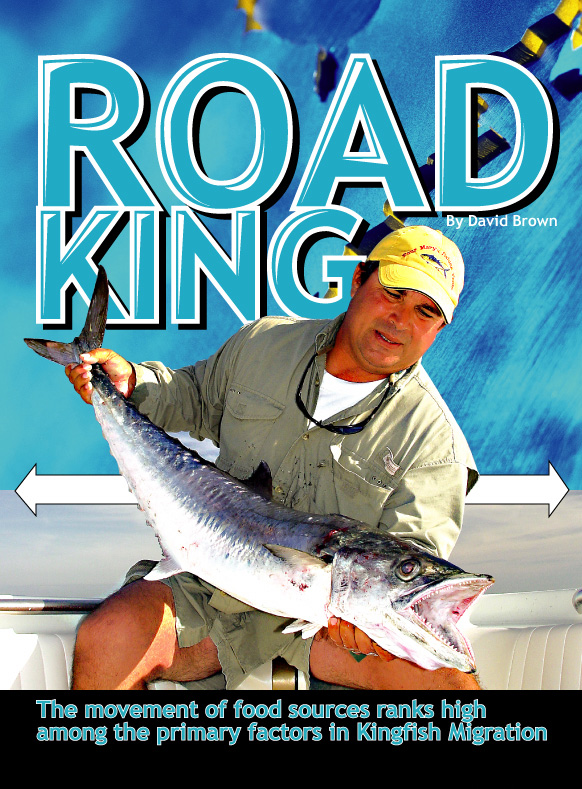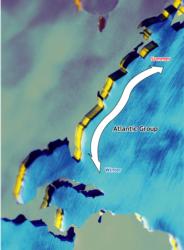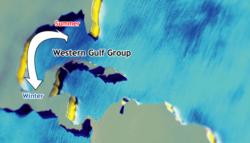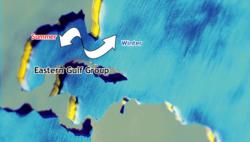Road king
Movement of food sources ranks high among primary factors in kingfish migration

Here is a classic chorus with an angling application: “Tramps like us, baby, we were born to run.”
I do not know if Bruce Springsteen or his lyrical love Wendy were into the angling arts, but The Boss sure captured a kingfish’s persona in the title track from his 1975 “Born to Run” album.
The fact is, the king mackerel (also referred to as kingfish or just “king”) is one of the Southeast’s most celebrated migratory species. With hordes of kings running up and down the Atlantic and Gulf coasts, tournament schedules are precisely planned based on historical patterns, fishing vacations are booked for maximum water time, and those of culinary inclinations stockpile oak, pine and hickory logs for rack smokers.
Notably, that word – smoker – also is used as yet another species nickname based partly on a popular method of kingfish preparation and partly on the fish’s habit of “smoking” a reel with its relentless, blazing runs.
 King mackerel roam North America’s coastal and nearshore waters from Virginia to Mexico, slashing through indigenous baitfish, shrimp, squid and reef species. Marine biologists and anglers generally agree that U.S. kingfish stocks comprise two main groups – the Atlantic group and the Gulf of Mexico group, with the latter subdivided into Eastern and Western clans.
King mackerel roam North America’s coastal and nearshore waters from Virginia to Mexico, slashing through indigenous baitfish, shrimp, squid and reef species. Marine biologists and anglers generally agree that U.S. kingfish stocks comprise two main groups – the Atlantic group and the Gulf of Mexico group, with the latter subdivided into Eastern and Western clans.
The Western group winters in Mexican waters and mingles with fish from the Eastern group around the mouth of the Mississippi River during the summer. The Eastern group spends its summers between the Florida panhandle and the Mississippi. When fall arrives, these fish turn south, passing through Florida’s central gulf coast in October-November and ending up in the Florida Keys by December. Around early March, the Eastern kings have headed back toward the northern region.
Capt. Todd Wood of St. Petersburg, Fla., recalls his father’s angling timetable: “My dad always took his vacations around Easter and Thanksgiving so we’d have kingfish to eat for (those holidays) That’s a good reference for fishing this area.”
In the Atlantic, most kingfish winter in south Florida, from Miami to the Keys. When spring warms coastal waters, the fish move northward, passing by Florida’s eastern ports between March and late May en route to their summer homes off Georgia, the Carolinas and Virginia. The first cold spells of September signal the southward run of baitfish – primarily mullet – and kings follow the chow.
Indeed, the movement of food sources ranks high among the primary factors in kingfish migration. Essentially, baitfish must remain within a comfortable temperature zone in the low- to mid-70s. When that zone moves, so do the bait and the kingfish. Water clarity factors here, too, as baitfish fare poorly in murky water. Thus, storms that stir the coastal environment or flooded rivers, pumping dirty water through the passes, will push the game offshore.
 The other migration motivation is spawning. As National Marine Fisheries Service biologist Mark Godcharles explained, kings generally move in one direction to survive winter and the other direction to perpetuate the species.
The other migration motivation is spawning. As National Marine Fisheries Service biologist Mark Godcharles explained, kings generally move in one direction to survive winter and the other direction to perpetuate the species.
“When kings migrate, so are many other forage species, and wherever the food goes, the predators will follow,” he said. “The fall movements are moving toward the wintering grounds – just to survive. Once winter (makes the) transition to spring and waters warm, kings move back north toward their spring and summer spawning grounds.”
Do all kingfish migrate? Considering the fact that northern Gulf anglers often bag monster kings near deep-water drilling rigs during January, when big smokers blanket Key West reefs, it would seem that some mature kings stake out favorable areas and set up permanent residence. Likewise, bottom fishermen targeting deep ledges and spikes off Florida’s central gulf coast often lament marauding kings that clip off their monofilament grouper rigs in mid-drop – well after the spring run has passed. The Florida Middle Grounds, located about 75 miles west of Tarpon Springs, are, in fact well-known for offseason kingfish action.
Elsewhere, fishing out of his home port in Stuart, Fla., Capt. Allen Winchel said he could find kings across the calendar. The spring months are just better in his area because of spawning aggregations.
“Kingfish is a year-round species (in this area), but you just get greater numbers of big fish during the migration period,” he said.
 As Winchel notes, anglers off southeast Florida can tell when the kingfish migration has started by looking for the commercial boats, locally called “buggers” because they fish feathered artificial rigs called “bugs” behind planers. Fishing mostly from inboard vessels, the buggers will circle an area when the bite is on. Trolling live baits through the area usually draws immediate interest.
As Winchel notes, anglers off southeast Florida can tell when the kingfish migration has started by looking for the commercial boats, locally called “buggers” because they fish feathered artificial rigs called “bugs” behind planers. Fishing mostly from inboard vessels, the buggers will circle an area when the bite is on. Trolling live baits through the area usually draws immediate interest.
Of these “resident kings,” Godcharles said: “It seems to me that there are some groups that are programmed to make long runs, while some of the kings show limited movement. Maybe as some of the fish get bigger, the biological requirements are no longer there to make those long treks, and they can find what they need in one area. There’s probably still a pretty strong drive to reach the spawning grounds.”
And then there is the oddball fish that seems compelled to travel more than others. Godcharles said he has seen kingfish tagged in Florida’s East Coast waters and recovered off Vera Cruz, Mexico. Likewise, many kings tagged off southeast Florida have turned up in the northern Gulf of Mexico.
Although king mackerel stocks are currently holding at healthy levels, the species nearly collapsed during the 1970s, when heavy commercial pressure and unregulated recreational catches levied a devastating toll. Tighter regulations for both groups gave the kings some breathing room, and the stocks responded quickly.
Today, the competitive kingfish arena now builds public interest in this tremendous fishery, but it also provides a platform from which to preach the conservation message. Kingfish seasons bring tremendous economic impact to port cities through tackle, fuel and food sales, and the fishing charter and hospitality industries.
Clearly, adhering to size and bag limits and carefully releasing non-keepers is the best way to ensure the kingfish migrations continue to deliver outstanding angling action.
Road rules
Part of the fun for tournament anglers is following kingfish throughout their range. Sometimes that is just running up the road to the next port; other times you cross state lines. Wherever you pursue this species, mind these points:
• Write It Down: If making a list and checking it twice works for Santa, it will work for kingfish anglers. A good way to cover all the items you will need is to completely off-load your boat, lay every piece of gear in plain sight, create an itemized list and identify any missing pieces. Make multiple laminated copies and give one to each team member.
• Homework: Researching key facts before arriving saves headaches during a tournament weekend. There is not much you cannot find online these days: historical catch data, bait and chum sources, restaurants, hotels and medical facilities, etc. When in doubt, give the local convention and visitors bureau a ring, and they will send maps, brochures and local directories.
• Pre-fishing: Arriving at least one day before the event not only helps you locate kings, but it also gives you time to find baitfish, gauge current conditions and make sure you can navigate local waterways and safely run the inlets. (You do not want to have to figure out the latter in the dark on tournament morning.)
• Safety First: Because many competitors burn the midnight oil before leaving for a tournament, put in long days of competition and then drive home after the event concludes, highway hazards loom large in this arena. Remain awake and alert by driving in shifts, playing upbeat music, rolling down the windows and arranging for someone back home to call your mobile phone at least once an hour. If fatigue becomes too great, stop for a nap or get a hotel room. A delayed return beats a highway accident.
• Provisions: Do not assume you will be able to find all the food, beverages, ice, chum, etc. that you need in the local market. Depending on the launch site, these items might not be within convenient reach on tournament morning. Play it safe and carry enough supplies to cover you for at least one day.